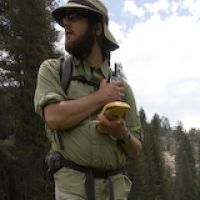Conklin et al., 2009
Seasonal transitions in water and moisture patterns in a mountain meadow, Southern Sierra Nevada (Invited).
Conklin, M.H., Crook, N.P., Kirchner, P.B., Lucas, R.G. (2009)
Fall meeting, American Geophysical Union, December 2009. 90(52). Abstract H41H-01.
-
Sierra, INVESTIGATOR
-
Sierra, GRAD STUDENT
-
Sierra, GRAD STUDENT
Abstract
We examined the seasonally changing water cycle in Long Meadow, located at an elevation of 2,200 m in Sequoia National Park, during the summers of 2008 and 2009 using:. i) continuous water-level and groundwater-flux measurements from wells and piezometers (3 transects), respectively , ii) streamflow measurements and geochemical sampling, iii) soil-moisture measurements, and iv) geophysical data from electromagnetic induction, resistivity and ground penetrating radar. Long Meadow is in a glaciated valley with alluvium depths of 15 m at its head and 33 m at its base, as determined by electrical resistivity tomography and ground penetrating radar. Surface sediments have up to 50% organic matter (on a dry weight basis). Although there are outlet and inlet streams, only parts of the meadow have well-defined stream channels. As the meadow dries out, the stream in the meadow becomes intermittent and groundwater becomes the major input, as indicated by stable water isotopes and water chemistry; values for the edge of the meadow were significantly different from those in the center. Electromagnetic-induction (EMI) surveys conducted in May, June and August 2008. showed spatial drying patterns that matched visual observations of patchy moisture distributions, with the lowest change in the upper part of the meadow. Maximum changes in EMI conductivity from May to August were from -78 to 100%. Piezometers on the edge of the meadow showed a negative gradient in late summer and loss of approximately 90 cm of hydraulic head from peak summer value; those in the center of the meadow show a positive gradient all year with a 10-cm loss of head over the summer. EMI conductivity changes were similar, with the center of the meadow showing little change and the edges showing an increase. It is only through the combined use of geophysical, physical and chemical measurements at different spatial and temporal scales, that we could gain a quantitative understanding of these seasonal patterns of moisture distribution.
Citation
Conklin, M.H., Crook, N.P., Kirchner, P.B., Lucas, R.G. (2009): Seasonal transitions in water and moisture patterns in a mountain meadow, Southern Sierra Nevada (Invited) . Fall meeting, American Geophysical Union, December 2009. 90(52). Abstract H41H-01..
Explore Further



